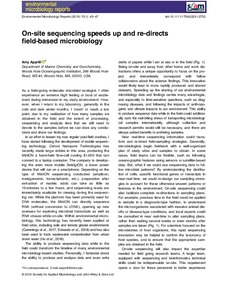| dc.contributor.author | Apprill, Amy | |
| dc.date.accessioned | 2021-02-08T21:40:01Z | |
| dc.date.available | 2021-02-08T21:40:01Z | |
| dc.date.issued | 2019 | |
| dc.identifier.citation | Apprill, A. (2019) On‐site sequencing speeds up and re‐directs field‐based microbiology. Environmental Microbiology Reports, 11, pp.45-47. DOI: https://doi.org/10.1111/1758-2229.12732 | en_US |
| dc.identifier.uri | http://hdl.handle.net/11329/1513 | |
| dc.identifier.uri | http://dx.doi.org/10.25607/OBP-1013 | |
| dc.description.abstract | As a field-going molecular microbial ecologist, I often
experience an extreme high feeling or bout of excitement
during immersion in my study environment. However,
when I return to my laboratory, generally in the
cold and dark winter months, I ‘crash’ or reach a low
point, due to my realization of how many samples we
obtained in the field and the extent of processing,
sequencing and analysis time that we still need to
devote to the samples before we can draw any conclusions
and share our findings.
In an effort to lessen my now regular post-field crashes, I
have started following the development of mobile sequencing
technology. Oxford Nanopore Technologies has
recently made large strides in this area, producing the
MinION a hand-held flow-cell costing $1,000 that can
connect to a laptop computer. The company is developing
the even more mobile SmidgION, a lower power
device that will run on a smartphone. Depending on the
type of MinION sequencing conducted (amplicon,
metagenomic, transcriptomic, etc.), preparation after
extraction of nucleic acids can take as little as
10-minutes to a few hours, and sequencing reads are
immediately available for viewing during the sequencing
run. While the platform has been primarily used for
DNA molecules, the MinION can directly sequence
RNA (without conversion to cDNA), opening up new
avenues for exploring microbial transcripts as well as
RNA viruses while on-site. Within environmental microbiology,
this technology has recently been applied at
field sites, including soils and remote glacier environments
(Cummings et al., 2017; Edwards et al., 2018) and has also
been used to track wastewater contamination from urban
storm water (Hu et al., 2018).
The ability to produce sequencing data while in the
field could transform the timeline of many environmental
microbiology-based studies... | en_US |
| dc.language.iso | en | en_US |
| dc.title | On-site sequencing speeds up and re-directs field-based microbiology. | en_US |
| dc.type | Journal Contribution | en_US |
| dc.description.refereed | Refereed | en_US |
| dc.format.pagerange | pp.45-47 | en_US |
| dc.identifier.doi | 10.1111/1758-2229.12732 | |
| dc.subject.parameterDiscipline | Parameter Discipline::Biological oceanography::Other biological measurements | en_US |
| dc.bibliographicCitation.title | Environmental Microbiology Reports | en_US |
| dc.bibliographicCitation.volume | 11 | en_US |
| dc.description.sdg | 14 | en_US |
| dc.description.bptype | Manual (incl. handbook, guide, cookbook etc) | en_US |
| obps.contact.contactemail | aapprill@whoi.edu | |
| obps.resourceurl.publisher | https://sfamjournals.onlinelibrary.wiley.com/doi/full/10.1111/1758-2229.12732 | en_US |
 Repository of community practices in Ocean Research, Applications and Data/Information Management
Repository of community practices in Ocean Research, Applications and Data/Information Management
